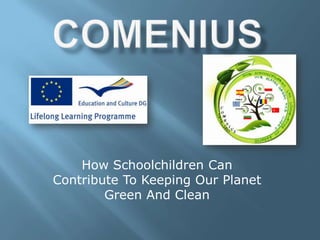Wetlands Greece
- 1. How Schoolchildren Can Contribute To Keeping Our Planet Green And Clean
- 2. Wetlands
- 3. Wetland is an area of land saturated with water either permanently or seasonally. It is characterised as having a water table that stands near or at the land surface for a long enough period to support aquatic life. The Ramsar International Wetland Conservation Treaty, an international agreement signed by 160 countries, has defined in clear terms what consists a wetland. The 2nd of February is World Wetlands day.
- 4. In Greece there are more than 400 wetland areas. There are 11 larger wetlands that are considered protected areas according to the Ramsar Convention.
- 5. As Samos is unique in terms of environmental characteristics, this project will focus on the wetlands of the island.
- 7. The wetland in Alyki is in the eastern part of Samos and very near the coast of Asia Minor. The region has been recognized as biotope and is included in NATURA 2000
- 8. Nearby Alyki, is the largest by far wetland of Mesokampos, also known as Valkamia, just 4.5 km east-northeast of Pythagorion. It covers 1400 acres and occupies the eastern part of Mesokampos, approximately half its surface. The 800 acres constitute a permanent marsh.
- 9. In the Pythagoreio Municipality region lays the Glyfades wetland, which comprises of the Small Glyfada, the Big Glyfada and the Chora marsh. Small Glyfada has water all year long and communicates with Big Glyfada with continuous flow. Its formation is due to the existence of many small springs that supply it with brackish water.
- 10. Samos hides a lot of surprises and one of them is the waterfalls in Potami,Karlovassi .
- 12. The flora and fauna that is found within the freshwater systems and their surrounding areas in Samos is diverse and ecologically important.
- 13. Each year, in the winter time the water in the wetland lakes raises and a lot of birds, flamingo, widgeons, swans and herons gather there. In the summertime the water disappears, the lake dries out and the birds leave it. Totally have been recorded 127 species of birds in the biotope.
- 14. One of the most important species is the flamingo. The Flamingos normally arrive at Alyki Wetland (the salt lake by Mykali) in the beginning of November and stay until February/March.
- 15. The flamingos used to breed in the wetlands of Samos but unfortunately scientists have found that they no longer manage to lay eggs here and when they do the hatchlings do not survive. This is due to human intervention of various forms that has limited the overall area of the wetlands.
- 16. Egretta garzetta ®C Little Egre They can be found in freshwater, brackish, or saline wetlands. Egretta garzetta has a preference for shallow wetlands in open sites where fish are close to the surface
- 17. Mammals of the biotope are hedgehogs, hares, black mice, jackals, while the amphibians and the reptiles are represented by frogs, river turtles, Greek turtles, chameleons, water snakes, lizards etc.
- 18. Human activities have taken their toll around the wetland areas, so it is our duty to actively protect this unique natural heritage of ours and not allow the wetlands to be destroyed.



















